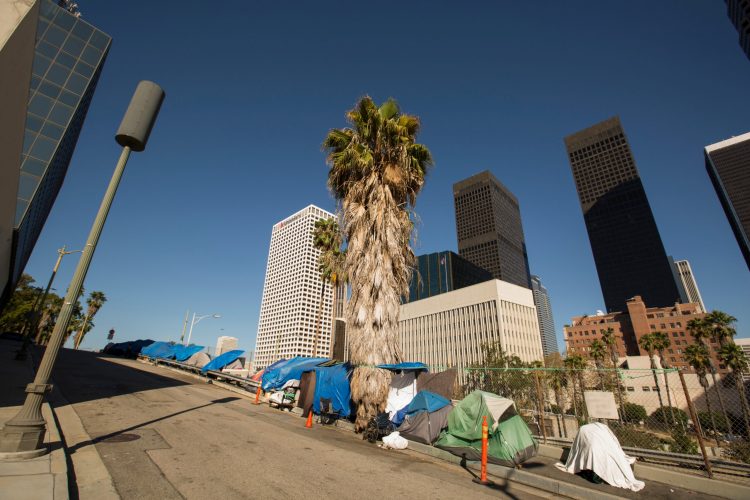America’s future cities:
A case for decentralization
As the virulence of the COVID pandemic subsided in 2020, a new phrase, “urban doom loop,” became a common way to describe the failure of America’s downtowns to recover economically. The concept is simple enough. As occupancy in downtown buildings declines, businesses that service those occupants decline, tax revenues decline, services are cut, thus causing still more businesses and commuters to relocate. This leads to a downward spiral.
COVID made everything worse. Concern about transmission meant that nobody wanted to get into light-rail cars or board buses. Over a year of veritable lockdown starved downtown businesses that catered to office workers. The explosion of online shopping drove countless retail establishments out of business. And the serendipitous (if you want to call it that) arrival of remote work as a completely viable alternative to most office jobs meant people didn’t have to commute downtown anymore.
In the aftermath of COVID the wreckage is everywhere. Notwithstanding political mistakes that make it harder for police to deter crime and manage homelessness, cities with depleted budgets have compounded that problem by reducing their police forces. Mass transit services, along with downtown parks, alleys and sidewalks are now overrun with criminals and homeless. Downtowns are not only economically depressed, they’re dangerous.
In March 2023 the Brookings Institution published a report “Breaking the ‘urban doom loop’: The future of downtowns is shared prosperity.” In that report, “shared prosperity” is presented as a solution that rejects the “false dichotomy” of cities v. suburbs. They argue that a robust downtown is “extremely important to their regional economy.” But their argument is thin, because it rests almost entirely on data that shows downtowns having a much higher “ratio of land area to tax assessed value.”
So what? Is it axiomatic that because real estate is worth more in dense downtowns, that compels us to increase the density of downtowns still further? Can downtowns be saved in this manner? Why not decentralize our urban landscape?
The authors of “Breaking the urban doom loop” are correct that downtowns are in more trouble than ever. California’s big downtowns have been gutted. Crime, retail failures, commercial vacancies, and a collapse in mass transit ridership have put them into obvious decline. The commercial office vacancy rate in Los Angeles is 22.5 percent, in San Francisco it is 32 percent. Both are record highs. Making matters much worse, as commercial leases expire they can no longer be renewed at the favorable ultra-low rates granted up until a few years ago. Many landlords will just hand the property over to the lender, leaving them with underwater assets and few options. That, too, will have a negative ripple effect. Conditions could get much worse before they begin to improve.
A common solution proposed, which on the surface makes compelling sense, is to convert empty commercial space into apartments. Why not? We have vacant space and we have a housing shortage. But it’s harder than it sounds. It isn’t enough to urgently lift regulatory obstacles and rezone. The conversions have to make financial sense, and in most cases, they don’t. Commercial offices, for example, typically only have one restroom per floor. This means that converting a high-rise or mid-rise building into a residential tower will require drilling holes for the bathroom plumbing through every floor in multiple places, from top to bottom, an extremely expensive job.
Notwithstanding the hard construction costs involved in conversion, which must be amortized, is the hard reality that except in the most high-end, gentrified echelons of urban residential real estate, the market price per square foot of leased commercial space greatly exceeds what the market will bear for residential space. Putting people into converted office buildings is a process that will require billions in government subsidies, if it is to happen at all. It’s a good idea, but it might not be economically feasible except in limited circumstances.
We’ve already seen what billions in misguided subsidies has done to our cities. Just this year, total spending on homeless programs in Los Angeles County will exceed $3 billion. Massive spending pursuant to the “housing first” ideology, whereby the “unhoused” must be offered “permanent supportive housing” before they can be treated for addiction, or trained for jobs, has turned the Southern California coast into a magnet for America’s unhoused.

Every year, California’s population of unhoused grows, despite record spending. Once again, solutions sound simple on the surface: we have vacant commercial and retail space, and we have an unhoused population. Voila. But the end result of this strategy would be downtowns that are still business wastelands, now filled with housing projects for the indigent. This is not a recipe that will turn the doom loop into a boom loop.
Before considering the whole “false dichotomy” between downtown development and suburban neighborhood development, two cold facts must be recognized. First, California’s laws that incentivize crime, substance abuse and vagrancy have to change. Police have to be allowed to prosecute individuals for these infractions, or the streets will never be safe. If these infractions were prosecuted and offenders were jailed for an appropriate period of time, it would immediately deter a high percentage of these activities. Suddenly the streets would be safer, unhoused people with options would exercise them and get off the streets, and police budgets would become manageable because deterrence would result in less need for law enforcement.
Second, the cost of housing, whether it is for low income working families, or unhoused individuals and families, is prohibitive in areas with high real estate values. It is also economically prohibitive in most cases to convert commercial space into unsubsidized market housing. These two facts lead to an uncomfortable conclusion that challenges the core premise of urban planners today, which is that higher downtown population densities are preferable.
You cannot create a chic, culturally rich downtown while at the same time filling your hotels and formerly commercial high rises with people who don’t work and aren’t sober. You will bankrupt your civic budget and you will scare away anyone with money and options. Successful downtowns, because they are beautiful and culturally rich, and because they host fabulously expensive buildings on the most expensive class of real estate there is, are by definition exclusive.
Despite these daunting reality checks, the preference for density over suburban expansion has become a quasi-religion among urban planners. It has spawned a robust industry of politically connected developers that collect subsidies and construct low-income and homeless housing in urban centers. And one of the central tenants supporting this religion is the conventional wisdom, allegedly beyond all debate, that higher density cities have less impact on the environment.
To understand this mentality, a 2005 study by the prestigious International Institute for Environment and Development called “The eco-city: ten key transport and planning dimensions for sustainable city development” offers an in-depth look. Their premise is clear enough, “the value systems and underlying processes of urban governance and planning need to be reformed to reflect a sustainability agenda.” In a lengthy analysis, they list several principles to realize this new vision.


Central to this vision of an “eco-city” is density, “a compact, mixed-use urban form,” where “freeway and road infrastructure are de-emphasized in favor of transit, walking, and cycling, and “the central city are human centers that absorb a high percentage of population growth.” The study goes on to decry “the negative consequences of low-density urban development,” and is rife with the usual paeans to inclusivity, walkability, and diversity, along with the obligatory condemnation of “NIMBYs” getting in the way of enlightened progress.
In the eyes of the densification lobby, Asian cities are held up as an example to emulate. According to the 2005 study, they have an average population density of nearly 40,000 people per square mile. That compares to San Francisco currently at just over 19,000 people per square mile, and the city of Los Angeles at nearly 9,000 people per square mile. But is the primary urban planning objective of higher density truly justifiable? Does it truly conform to the realities of economic geography and the obligations of environmental responsibility?
According to a recent, and very contrarian study, “The Next American Cities,” published by the Urban Reform Institute, the answer to that question is emphatically no. In a thorough discussion of every possible objection to urban expansion, co-authors Joel Kotkin and Wendell Cox take to pieces the density arguments. Some of them should be self-evident by now.
For example, work from home technology has matured, with the pandemic constituting its shakedown cruise. Over 50% of the entire U.S. workforce was able to work remotely during the pandemic, up from only 7% pre-pandemic, and it is currently estimated that even with the pandemic over the at-home workforce may not shrink below one-third of the workforce. This is a seismic shift. Downtown commercial real estate cannot recover from this unless either the overall metropolitan population of potential downtown commuters increases enough to make up for the loss, or something lures people back into the office. It also means that pressure on access roads will be permanently reduced as there are fewer commuters.
There’s another trend, however, decades in the making, that will not abate, which is the fact that jobs and people are migrating to suburbs. In town centers, industrial parks and dedicated campuses, employers continue to relocate to where people live. This decentralization may depopulate downtowns, but it’s following the job market and invigorating satellite cities. And what about the impact of “sprawl” on the environment?
The first thing to realize here is that California, a vast state, is nonetheless the most densely populated in its urban areas. Over 94% of California’s population lives in urban areas, which occupy barely 5% of its land area. This fact, a result of relatively late settlement, combined with remarkable investments in infrastructure back in the 1950s and 1960s to bring water and power to attractive coastal areas, means California is already at the front of America’s forced-density pack. This means there is an incredible amount of land still available for development. The numbers are inescapable.
If California added 10-million new residents, increasing its population from nearly 40 million to 50 million, and every one of those new residents lived in four-person households on quarter-acre lots, with an equal amount of land set aside for schools, parks, roads, and retail and commercial centers, it would only consume 2,000 square miles, a mere 1.5-percent of California’s total land area. To put this in perspective, California has 25,000 square miles of unirrigated rangeland used for cattle ranching. Less than 10 percent of that land could be covered with new suburbs accommodating 10 million people living in single family homes on spacious lots. Why not?
Probably the most significant finding reported in the Urban Reform Institute’s study was the clear preference of families, seniors, Hispanics, African Americans, Asian Americans and the foreign born to live in single-family detached homes, located in suburbs and exurbs. As the study scrupulously documents, more than 80 percent of the nation’s metropolitan population now live in suburbs and exurbs, capping a growth trend that has been consistent for over 50 years. And the general preference for more space has only accelerated since the pandemic.
Arguments in favor of more suburban development are comprehensive. There is plenty of available land. The transportation impact is overstated due to remote work and jobs following people to suburbs. Cars are becoming emissions free and autonomous, greatly reducing their impact on the environment. The cost per square foot to construct housing in the urban core is far greater than in suburbs both because the real estate is more costly, and because multi-story residential structures have a much higher per square foot construction cost than wood framed or pre-fab single and two story single family homes.
Low density, leafy suburbs have a lower per capita heat island impact than dense cities. Energy and water efficiency can be practiced in single family homes just as effectively as they can be practiced in urban high rises. Irrigated residential landscaping can be a ecologically healthy asset, beneficial for the environment. And the vast majority of Americans prefer living in detached homes in suburban communities. Higher density is fine to the degree that people want it and the market creates it – but it shouldn’t be the goal of policy makers to force it.
Ultimately the objections to suburbs must be evaluated in terms of what special interests have a stake in these policy decisions. Environmentalists may hold every acre of greenfield in sacred esteem, but if that value were prevalent and determinative in previous decades, urban civilization would not exist. Cities and suburbs alike, and the infrastructure necessary to supply them with water, energy, transportation, food and waste management, have an inevitable footprint. It isn’t at all clear that concentrating humans in city centers is ecologically preferable, even if the formidable economic obstacles could be overcome. But policies to cordon off and densify California’s cities is not happening merely to protect the environment.
When the supply of land is artificially constrained, property values go up, which increases property tax revenues to existing public sector jurisdictions. Building new cities on raw land reallocates these tax revenues to new cities. Similarly, when home building is excessively regulated to the point where affordable housing can no longer be profitably constructed and sold at market prices, politically connected developers collect billions from the government to build subsidized housing.
And if water and energy consumption is rationed, it relieves the obligation of the government to facilitate new investments in water and energy supply infrastructure despite its feasibility and sustainability. That money can instead go to failed social programs such as ultra-expensive public housing projects, and to higher wages and benefits for government employees. And it would be remiss to not point out that expensive renewable energy allows public utilities, which earn profit on a capped percent of revenue, to greatly increase their absolute profits because they are selling the same quantity of electricity at much higher prices.
These are some of the darker possible motivations underlying the densification lobby and the power behind it. There is a lot of money to be made by cramming people into smaller spaces. But under scrutiny, densification does not have a significant ecological benefit, and it comes with a costly price both economically and in terms of how it degrades the quality of life and limits the choices for millions of families.
Instead of rescuing our downtowns through further densification, why not de-densify them? Clear the streets and make them safe again by putting homeless into dedicated shelters using popup tents on inexpensive industrial land, and put lawbreakers in jail. In both cases, it may be the first chance they’ve ever had to recover their dignity and restart their lives. This will save billions of dollars when compared to the “permanent supportive housing” scam.
Create new spaces and new opportunities in the middle of central downtowns by demolishing commercial and residential buildings that are no longer economically viable. Central downtowns cannot be recreated as they were. They are not doomed, but they are morphing again and reinventing them must accept the overall reality of decentralization. By embracing a strategy of decentralization, ironically, downtown real estate may come down enough in value that downtowns can once again become cultural magnets, if not commercial magnets, because the so-called Bohemian “cultural creatives” will be once again able to afford to live and congregate there. More density and less density can actually coexist at the same time.
To make it all work, the trend in state infrastructure policies must be reversed, to deregulate energy and water development so private companies can afford to build new supply infrastructure, with public funds making up the difference. At the same time, the state must reverse course and deregulate and encourage new suburbs on the open periphery of urban areas, so as to vastly increase the supply of homes, which will make them as affordable today as they were in the 1950s. It can be done. Housing markets are regional, so home values won’t moderate unless the state allows suburban construction as well as urban projects.
This is the contrarian, people-centric urban vision that utterly defies the common orthodoxy. It is needed now more than ever. It will usher in the shared prosperity of a metropolitan mega-boom that benefits everyone.
Edward Ring is a co-founder of the California Policy Center and the author of “The Abundance Choice: Our Fight for More Water in California.”

